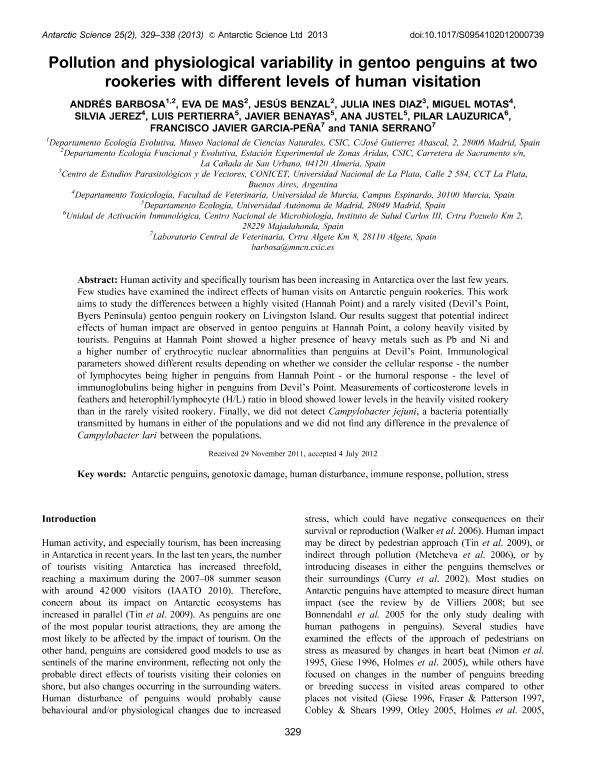Mostrar el registro sencillo del ítem
dc.contributor.author
Barbosa, Andrés
dc.contributor.author
De Mas, Andrea
dc.contributor.author
Benzal, Jesús
dc.contributor.author
Diaz, Julia Inés

dc.contributor.author
Motas, Miguel
dc.contributor.author
Jerez, Silvia
dc.contributor.author
Pertierra, Luis
dc.contributor.author
Benayas, Luis
dc.contributor.author
Justel, Ana
dc.contributor.author
Lauzurica, Pilar
dc.contributor.author
García Peña, Francisco Javier
dc.contributor.author
Serrano, Tania
dc.date.available
2017-01-03T18:39:53Z
dc.date.issued
2013-04
dc.identifier.citation
Barbosa, Andrés; De Mas, Andrea; Benzal, Jesús; Diaz, Julia Inés; Motas, Miguel; et al.; Pollution and physiological variability in gentoo penguins at two rookeries with different levels of human visitation; Cambridge University Press; Antarctic Science; 25; 2; 4-2013; 329-338
dc.identifier.issn
0954-1020
dc.identifier.uri
http://hdl.handle.net/11336/10768
dc.description.abstract
Human activity and specifically tourism has been increasing in Antarctica over the last few years. Few studies have examined the indirect effects of human visits on Antarctic penguin rookeries. This work aims to study the differences between a highly visited (Hannah Point) and a rarely visited (Devil’s Point, Byers Peninsula) gentoo penguin rookery on Livingston Island. Our results suggest that potential indirect effects of human impact are observed in gentoo penguins at Hannah Point, a colony heavily visited by tourists. Penguins at Hannah Point showed a higher presence of heavy metals such as Pb and Ni and a higher number of erythrocytic nuclear abnormalities than penguins at Devil’s Point. Immunological parameters showed different results depending on whether we consider the cellular response - the number of lymphocytes being higher in penguins from Hannah Point - or the humoral response - the level of immunoglobulins being higher in penguins from Devil’s Point. Measurements of corticosterone levels in feathers and heterophil/lymphocyte (H/L) ratio in blood showed lower levels in the heavily visited rookery than in the rarely visited rookery. Finally, we did not detect Campylobacter jejuni, a bacteria potentially transmitted by humans in either of the populations and we did not find any difference in the prevalence of Campylobacter lari between the populations.
dc.format
application/pdf
dc.language.iso
eng
dc.publisher
Cambridge University Press

dc.rights
info:eu-repo/semantics/openAccess
dc.rights.uri
https://creativecommons.org/licenses/by-nc-sa/2.5/ar/
dc.subject
Antarctic Penguins
dc.subject
Genotoxic Damage
dc.subject
Human Disturbance
dc.subject
Immune Response
dc.subject
Pollution
dc.subject
Stress
dc.subject.classification
Conservación de la Biodiversidad

dc.subject.classification
Ciencias Biológicas

dc.subject.classification
CIENCIAS NATURALES Y EXACTAS

dc.subject.classification
Ecología

dc.subject.classification
Ciencias Biológicas

dc.subject.classification
CIENCIAS NATURALES Y EXACTAS

dc.title
Pollution and physiological variability in gentoo penguins at two rookeries with different levels of human visitation
dc.type
info:eu-repo/semantics/article
dc.type
info:ar-repo/semantics/artículo
dc.type
info:eu-repo/semantics/publishedVersion
dc.date.updated
2016-12-12T14:10:37Z
dc.identifier.eissn
1365-2079
dc.journal.volume
25
dc.journal.number
2
dc.journal.pagination
329-338
dc.journal.pais
Reino Unido

dc.journal.ciudad
Cambridge
dc.description.fil
Fil: Barbosa, Andrés. Consejo Superior de Investigaciones Cientificas; España. Museo Nacional de Ciencias Naturales. Departamento Ecología Evolutiva; España. Consejo Superior de Investigaciones Cientificas. Estacion Experimental de Zonas Aridas; España
dc.description.fil
Fil: De Mas, Andrea. Consejo Superior de Investigaciones Cientificas. Estacion Experimental de Zonas Aridas; España
dc.description.fil
Fil: Benzal, Jesús. Consejo Superior de Investigaciones Cientificas. Estacion Experimental de Zonas Aridas; España
dc.description.fil
Fil: Diaz, Julia Inés. Consejo Nacional de Investigaciones Científicas y Técnicas. Centro Científico Tecnológico La Plata. Centro de Estudios Parasitológicos y de Vectores (i); Argentina. Universidad Nacional de La Plata. Facultad de Ciencias Naturales y Museo; Argentina
dc.description.fil
Fil: Motas, Miguel. Universidad de Murcia; España
dc.description.fil
Fil: Jerez, Silvia. Universidad de Murcia; España
dc.description.fil
Fil: Pertierra, Luis. Universidad Autónoma de Madrid; España
dc.description.fil
Fil: Benayas, Luis. Universidad Autónoma de Madrid; España
dc.description.fil
Fil: Justel, Ana. Universidad Autónoma de Madrid; España
dc.description.fil
Fil: Lauzurica, Pilar. Universidad Carlos III de Madrid. Instituto de Salud; España
dc.description.fil
Fil: García Peña, Francisco Javier. Laboratorio Central de Veterinaria; España
dc.description.fil
Fil: Serrano, Tania. Laboratorio Central de Veterinaria; España
dc.journal.title
Antarctic Science

dc.relation.alternativeid
info:eu-repo/semantics/altIdentifier/doi/https://doi.org/10.1017/S0954102012000739
dc.relation.alternativeid
info:eu-repo/semantics/altIdentifier/url/https://www.cambridge.org/core/journals/antarctic-science/article/pollution-and-physiological-variability-in-gentoo-penguins-at-two-rookeries-with-different-levels-of-human-visitation/245B7A9C38443E1D19F112694E651CAE
Archivos asociados
